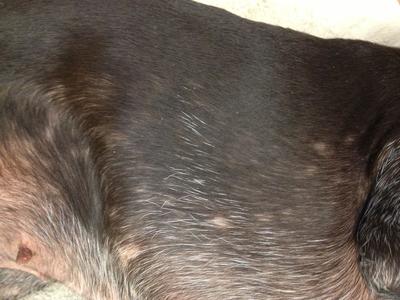Skin issues and problems in dogs are becoming more and more common. These may be due to an environmental trigger such as certain plants and grasses or dust, diet-related, a depressed immune system, parasites like fleas or numerous other causes.
Read ahead to find out about the common skin problems in dogs, the factors that can cause them, and how you can deal with these best.

Pattern Baldness (or Canine Pinnal Alopecia)
Pattern baldness is likely to affect many dogs at one point or another, and it is a harmless condition. This involves the thinning and sometimes loss of fur, usually in specific areas. Most commonly, this condition can be seen around the neck, ears, temples, and stomach area.
The thinning and loss of fur can begin as early as puberty in these dogs, and the skin becomes darkened. If you notice this in your pet, it is important to go to a vet to rule out any other conditions. Since this condition is harmless and will not cause any pain or discomfort to your pet, it is not a cause of worry.
However, there are melatonin supplements and dietary supplements for fur and skin can sometimes promote regrowth of the fur.
Acanthosis Nigricans
This pigmentation condition is a lifelong skin condition that can develop when the dog is still a puppy. The skin appears discolored, dark, and thick and your pet’s fur may begin to fall out. It is possible that the dog may develop a condition known as seborrhea, a flaky and itchy skin problem like dandruff.
This dermatological issue can be seen first in the armpit areas, and later the groin and abdomen. Though there is no cure, there are several ways to manage the condition, as well as steps that you can take to prevent complications.
Most often, this involves prescription shampoos that your vet will suggest, along with steroids and supplements for dermatological health.
Malassezia Dermatitis (Yeast Infections)
Yeast infections of the dermis in dogs are not uncommon with many breeds and often co-occur with acanthosis nigricans. It is caused by a fungus and can be identified by the development of a rash, which your pet may itch at frequently.
This rash soon becomes infected, giving off a musty, foul odor. The skin may become thick and dark, or become red with itching. This is not a contagious condition and it can be treated. Your dog’s vet may prescribe a topical or oral treatment, including medicated shampoos to be used once or twice a week. You may also be given ointments for daily use and anti-fungal oral medications.
Skin Tumors
It is possible for your pet to develop lumps on the dermis that can be dangerous but are most often benign. Generally, it is not uncommon for malignant and benign tumors in dogs to be removed with surgery.
Cancer treatment such as radiation and chemotherapy can prolong a dog’s lifespan. While you cannot prevent a tumor from developing, you can take care to watch for any signs of lumps or bumps. See a vet at once if you should come across any. This way you will be able to deal with potentially malignant growths as early as possible.
How to Reduce Your Pet’s Risk of Developing These Conditions
You may not be able to fully avoid some of these conditions as many dogs, especially pure breeds are prone to many of them. You can, however, reduce the risk involved with a few simple steps. Mostly, all you need to do is make sure your pet is getting the right kind of diet to promote healthy skin. You should also keep him or her well groomed and clean, and frequently check for signs of abnormalities.
Long-haired dogs will need more frequent baths than short haired-dogs, but it is generally best to bathe a dog once every one to three months. You would only need more or less frequent bathing if the vet recommends it because of a condition. For more on How to bathe a dog see here.
If you bathe your dog too frequently, it can remove healthy natural oils and dry out the skin. Make sure you use the correct shampoo and not human soaps or shampoos, as it is easy to cause dermal irritation. If your dog has a skin condition, follow the vet’s directions carefully for grooming and bathing.
Be sure to brush your dog once a week, or daily if the fur is long, to prevent matting and tangling. First, use a wide-toothed comb and then a brush. For more on how to brush a dog see here
Take this opportunity to look over the dog’s body, paying special attention to the stomach area, face, behind the ears, and behind the legs. Look through the fur for tick and fleas, as well as any signs of developing or worsening dermatological problems. These parasites and mites can cause rashes and infections.
In addition, take care not to use harsh detergents, fragrances, or pesticides around the house, as these can be irritants for your pet’s skin. Keep an eye out for any allergic reactions caused by an environmental factor such as fabric or plants. If you know whether your pet’s parents or siblings had any diseases, it can be a good indication or how much of a risk you are dealing with.
It is important that you give your dog a little treat after every bath, inspection, and brushing. Make sure that they are getting a healthy diet specific to their breed. It should contain plenty of good fatty acids to promote healthy skin. If you have any concern about the health of your dog, do not hesitate to consult a vet.